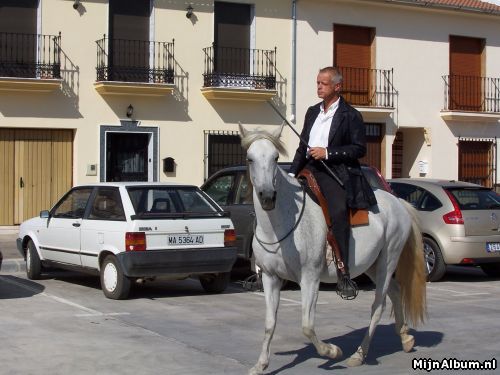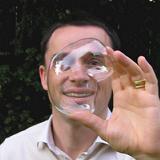|
|
| Author |
Message |
Chevalier

|
 Posted: Sun Feb 24, 2008 7:25 pm Dom Duarte (contemporary) Posted: Sun Feb 24, 2008 7:25 pm Dom Duarte (contemporary) |
 |
|
And just to proof that the Master's teachings are still alive, a fellow neckring rider from Europe:
| Description: |
|
| Filesize: |
40.12 KB |
| Viewed: |
30785 Time(s) |

|
|
|
|
 |
Inigo

Location: Auckland
|
 Posted: Sun Feb 24, 2008 8:07 pm Posted: Sun Feb 24, 2008 8:07 pm |
 |
|
How do you say "STOP!" in capitals, with a neck ring. When leaning back in the saddle doesn't do the job...
_________________
A book may be able to teach you something of fighting, but it can't cover your back when the shield wall breaks up! |
|
|
 |
gt1cm2
Location: Wellington
|
 Posted: Sun Feb 24, 2008 8:16 pm Posted: Sun Feb 24, 2008 8:16 pm |
 |
|
Try this one then Inigo, no nothing!!
http://www.youtube.com/watch?v=XxUGEN9kS9o
Actually using a neckring is quite common among natural horsemanship guys.
_________________
did they beat the drums slowly
did the play the fife lowly
did they sound the death march as they lowered you down
did the band play the last post and chorus
did the pipes play the flowers of the forest |
|
|
 |
Chevalier

|
 Posted: Mon Feb 25, 2008 8:41 pm Posted: Mon Feb 25, 2008 8:41 pm |
 |
|
| Quote: | | How do you say "STOP!" in capitals, with a neck ring. |
Ehem, by leaning back and raising the neckring higher up the neck as needed? Of course, horse and rider need to be trained, usually by combining reins and neckring for a while, then riding with just the neckring in a fenced off arena, then -ultimatively- hacking out. Also, you might already be aware that not even a long-shanked curb/very sharp bit is going to stop a horse that really doesn't want to stop.
Riding a horse with or without gear is an art that needs constant cooperation and work and is also a sport that can be dangerous at any time (like mountain biking etc). Either way, there are quite a few bridleless or neckring rider out there - if the concept is genuinely new to you, browse Youtube and Co. You will find truly inspirational clips!
|
|
|
 |
Baroque

Location: Auckland
|
 Posted: Fri Feb 29, 2008 8:47 am Posted: Fri Feb 29, 2008 8:47 am |
 |
|
I started Mr M with a neck strap and lunge cavesson and rode him like that for a long time as he gradually got used to the bridle & bit. It was rather a handful as I had basically a full set of reins [a la double bridle, one pair from the cavesson, one pair from the snaffle], plus the neck strap as another pair of reins and I also held a whip in each hand.
I stopped using the neck strap regularly with him about 6mths down the line as he had started leaning on it and I needed to teach him how to carry himself properly and was having problems getting enough instant give forwards with handling all those reins!
I still put the horses back on a neck strap from time to time if I want to work on a few things as it keeps them able to work with a number of different inputs which can be useful. Zen was particularly great to ride on a neck strap and we got very good at doing all her canter work on it.
The design [and length] of the rein is important for comfort - I use an old web rein for the part that goes thru my hands, it is attached to a thick cord which is the piece that contacts the horses neck. Some people use plaited baling twine however I found that cut my hands too much.
_________________
--likes sharp shiny objects and hits things with big sticks--
 |
|
|
 |
Chevalier

|
 Posted: Fri Feb 29, 2008 8:54 pm Materials used Posted: Fri Feb 29, 2008 8:54 pm Materials used |
 |
|
Most people I know use a stiff neck ring made of lariat rope and adjustable in size (flexible and easy to use). However, I know of two people who use old gardening hose that's wrapped (smart idea!) for their thick-necked Baroque horses.
As for the forward and lenghtening strides - I agree that a neckring might not be the best option for this kind of riding. I suggest using it from time to time, for example on easy trekking events with other safe horses or for cooling down after work.
It is mostly an (occassional) excercise of freedom and trust...
|
|
|
 |
Chevalier

|
 Posted: Fri Oct 30, 2009 12:24 pm Archeologists Overheard... Posted: Fri Oct 30, 2009 12:24 pm Archeologists Overheard... |
 |
|
Anyone else who can confirm this??
"I have a client who is an archaeology student. She says one of the
ways they are taught to tell whether the equine bones they find are
those of a feral or a domestic horse is the fact that domestic horses
have hairline cracks in their jaws that are the result of bit use."
|
|
|
 |
Boyd

Location: London
|
 Posted: Fri Oct 30, 2009 6:20 pm Posted: Fri Oct 30, 2009 6:20 pm |
 |
|
I can't confirm it but it would make sense, especially the way you see some people sawing on the horses mouth.
I recall seeing an ME (can't remember where) bit which I wouldn't want anywhere near my mouth.
Not that I'm that keen on using a modern bit in my own mouth...
_________________
Experience is not what happens to a man; it is what a man does with what happens to him.
Aldous Huxley in "Texts and Pretexts", 1932 |
|
|
 |
Gaius Drustanus
This account is inactive
Location: auckland
|
 Posted: Thu Nov 12, 2009 5:28 pm Posted: Thu Nov 12, 2009 5:28 pm |
 |
|
Yeah I saw something like this on Sky History Channel. The earlier/earliest evidence for the domesticated horse comes , I think, from the Eurasian Steppe about 4000(?) or more years ago. Changes in the Jaw and teeth roots. waear and tear thereon.
_________________
Disclaimer:Opinions expressed by Warlord Drustan, this debauched demented megalomaniac are solely his own & do not reflect those of LegioIIAugusta or the Roman people in any way. |
|
|
 |
|
 Please read the terms of use
Please read the terms of use
 Contact the Site Admin
Contact the Site Admin



